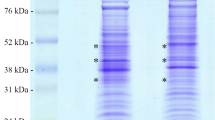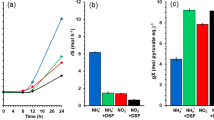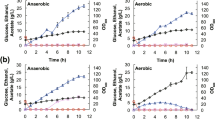Abstract
The ability of taxonomically different yeasts to synthesize pyruvic acid (PA) from glucose was studied. The study showed that many yeasts are able to produce PA from glucose under the condition of growth limitation by thiamine. This ability was found in the yeast Blastobotrys adeninivorans for the first time. The production (oversynthesis) of PA in this yeast can be explained by disturbance in the function of thiamine-dependent pyruvate dehydrogenase. Namely, the partial inhibition of this enzyme brings about the excretion of PA from the yeast cells. Due to incomplete inhibition of pyruvate dehydrogenase, the formation of acetyl-CoA continues, although at a lower level, maintaining the synthesis of α-ketoglutaric acid (KGA) in the tricarboxylic acid (TCA) cycle. KGA is no longer oxidized in the TCA cycle, because thiamine limitation inhibits α-ketoglutarate dehydrogenase. As a result, KGA is excreted from the yeast cells as a byproduct of PA oversynthesis. Furthermore, the increased level of KGA in the yeast cells inhibits NAD-dependent isocitrate dehydrogenase in the TCA cycle and enhances the production and excretion of citric acid, another byproduct of PA oversynthesis. During cultivation in a fermentor, the strain Blastobotrys adeninivorans VKM Y-2677 produced 43.2 g l−1 PA from glucose with a product yield (YPA) of 0.77 g PA/g glucose. The proportion of PA to byproducts was 18:1 for KGA and 8:1 for citric acid.


Similar content being viewed by others

References
Böer E, Breuer FS, Weniger M, Denter S, Piontek M, Kunze G (2011) Large-scale production of tannase using the yeast Arxula adeninivorans. Appl Microbiol Biotechnol 92:105–114
Burkholder P, McVeigh J, Moyer D (1944) Studies on some growth factors of yeasts. J Bacteriol 48:385–391
Causey TB, Shanmugam KT, Yomano LP, Ingram LO (2003) Engineering Escherichia coli for efficient conversion of glucose to pyruvate. Proc Natl Acad Sci U S A 101:2235–2240
Cohen GN (2011) Biosynthesis of amino acids derived from phosphoglyceric acid and pyruvic acid. In: Cohen GN (ed) Microbial biochemistry 2nd edn. Springer, Netherlands, pp. 347–361
Finogenova TV, Morgunov IG, Kamzolova SV, Chernyavskaya OG (2005) Organic acid production by the yeast Yarrowia lipolytica: a review of prospects. Appl Biochem Microbiol 41:418–425
Gellissen G, Kunze G, Gaillardin C, Cregg JM, Berardi E, Veenhuis M, van der Klei I (2005) New yeast expression platforms based on methylotrophic Hansenula polymorpha and Pichia pastoris and on dimorphic Arxula adeninivorans and Yarrowia lipolytica—a comparison. FEMS Yeast Res 5:1079–1096
Guo H, Madzak C, Du G, Zhou J, Chen J (2014) Effects of pyruvate dehydrogenase subunits overexpression on the α-ketoglutarate production in Yarrowia lipolytica WSH-Z06. Appl Microbiol Biotechnol 98:7003–7012
Hollmann R, Deckwer WD (2004) Pyruvate formation and suppression in recombinant Bacillus megaterium cultivation. J Biotechnol 111:89–96
Inoue T, Murakami N, Ayabe T, Oto Y, Nishino I, Goto YI, Koga Y, Sakuta R (2016) Pyruvate improved insulin secretion status in a mitochondrial diabetes mellitus patient. J Clin Endocrinol Metab 101(5):1924–1926
Jankowska DA, Trautwein-Schult A, Cordes A, Hoferichter P, Klein C, Bode R, Baronian K, Kunze G (2013) Arxula adeninivorans xanthine oxidoreductase and its application in the production of food with low purine content. J Appl Microbiol 115:796–807
Zhu Y, Eiteman MA, Altman R, Altman E (2008) High glycolytic flux improves pyruvate production by a metabolically engineered Escherichia coli strain. Appl Environ Microbiol 4:6649–6655
Koh-Banerjee PK, Ferreira MP, Greenwood M, Bowden RG, Cowan PN, Almada AL, Kreider RB (2005) Effects of calcium pyruvate supplementation during training on body composition, exercise capacity, and metabolic responses to exercise. Nutrition 21:312–319
Kunze G, Gaillardin C, Czernicka M, Durrens P, Martin T, Böer E, Gabaldón T, Cruz JA, Talla E, Marck C, Goffeau A, Barbe V, Baret P, Baronian K, Beier S, Bleykasten C, Bode R, Casaregola S, Despons L, Fairhead C, Giersberg M, Gierski PP, Hähnel U, Hartmann A, Jankowska D, Jubin C, Jung P, Lafontaine I, Leh-Louis V, Lemaire M, Marcet-Houben M, Mascher M, Morel G, Richard GF, Riechen J, Sacerdot C, Sarkar A, Savel G, Schacherer J, Sherman DJ, Stein N, Straub ML, Thierry A, Trautwein-Schult A, Vacherie B, Westhof E, Worch S, Dujon B, Souciet JL, Wincker P, Scholz U, Neuvéglise C (2014) The complete genome of Blastobotrys (Arxula) adeninivorans LS3—a yeast of biotechnological interest. Biotechnol Biofuels 7:66
Li Y, Chen J, Lun SY (2001) Biotechnological production of pyruvic acid. Appl Microbiol Biotechnol 57:451–459
Liu LM, Xu QL, Li Y, Shi ZP, Zhu Y, Du GC, Chen J (2007) Enhancement of pyruvate production by osmotic-tolerant mutant of Torulopsis glabrata. Biotechnol Bioeng 97:825–832
Morgunov IG, Kamzolova SV, Perevoznikova OA, Shishkanova NV, Finogenova TV (2004a) Pyruvic acid production by a thiamine auxotroph of Yarrowia lipolytica. Process Biochem 39:1469–1474
Morgunov IG, Kamzolova SV, Sokolov AP, Finogenova TV (2004b) The isolation, purification, and some properties of NAD-dependent isocitrate dehydrogenase from the organic acid-producing yeast Yarrowia lipolytica. Microbiology (Moscow) 73:249–254
Morgunov IG, Kamzolova SV, Samoilenko VA (2013) Enhanced α-ketoglutaric acid production and recovery in Yarrowia lipolytica yeast by effective pH controlling. Appl Microbiol Biotechnol 97:8711–8718
Otto C, Yovkova V, Aurich A, Mauersberger S, Barth G (2012) Variation of the by-product spectrum during α-ketoglutaric acid production from raw glycerol by overexpression of fumarase and pyruvate carboxylase genes in Yarrowia lipolytica. Appl Microbiol Biotechnol 95:905–917
Rywińska A, Juszczyk P, Wojtatowicz M, Robak M, Lazar Z, Tomaszewska L, Rymowicz W (2013) Glycerol as a promising substrate for Yarrowia lipolytica biotechnological applications. Biomass Bioenergy 48:148–166
Stottmeister U, Aurich A, Wilde H, Andersch J, Schmidt S, Sicker D (2005) White biotechnology for green chemistry: fermentative 2-oxocarboxylic acids as novel building blocks for subsequent chemical syntheses. J Ind Microbiol Biotechnol 32:651–664
Tomar A, Eiteman MA, Altman E (2003) The effect of acetate pathway mutations on the production of pyruvate in Escherichia coli. Appl Microbiol Biotechnol 62:76–82
van Maris AJ, Geertman JM, Vermeulen A, Groothuizen MK, Winkler AA, Piper MD, van Dijken JP, Pronk JT (2004) Directed evolution of pyruvate decarboxylase-negative Saccharomyces cerevisiae, yielding a C2-independent, glucose-tolerant, and pyruvate-hyperproducing yeast. Appl Environ Microbiol 70:159–166
Wang QH, He P, Lu DJ, Shen A, Jiang N (2002) Screening of pyruvate-producing yeast and effect of nutritional conditions on pyruvate production. Lett Appl Microbiol 35:338–342
Workman M, Holt P, Thykaer J (2013) Comparing cellular performance of Yarrowia lipolytica during growth on glucose and glycerol in submerged cultivations. AMB Express 3(1):58. doi:10.1186/2191-0855-3-58
Xu P, Qiu J, Gao C, Ma C (2008) Biotechnological routes to pyruvate production. J Biosci Bioeng 105:169–175
Yanai T, Tsunekawa H, Okamura K, Okamoto R (1994) Manufacture of pyruvic acid with Debaryomyces. Japan patent patent 0600091
Yin X, Madzak C, Du G, Zhou J, Chen J (2012) Enhanced alpha-ketoglutaric acid production in Yarrowia lipolytica WSH-Z06 by regulation of the pyruvate carboxylation pathway. Appl Microbiol Biotechnol 96:1527–1537
Yudina NY, Arlyapov VA, Chepurnova MA, Alferov SV, Reshetilov AN (2015) A yeast co-culture-based biosensor for determination of waste water contamination levels. Enzym Microb Technol 78:46–53
Zelić B, Gostovic S, Vuorilehto K, Vasić-Racki D, Takors R (2004) Process strategies to enhance pyruvate production with recombinant Escherichia coli: from repetitive fed-batch to in situ product recovery with fully integrated electrodialysis. Biotechnol Bioeng 85:638–646
Author information
Authors and Affiliations
Corresponding author
Ethics declarations
Competing interests
The authors declare that they have no competing interests.
Ethical statement
This article does not contain any studies with human participants performed by any of the authors.
Rights and permissions
About this article
Cite this article
Kamzolova, S.V., Morgunov, I.G. Biosynthesis of pyruvic acid from glucose by Blastobotrys adeninivorans . Appl Microbiol Biotechnol 100, 7689–7697 (2016). https://doi.org/10.1007/s00253-016-7618-1
Received:
Revised:
Accepted:
Published:
Issue Date:
DOI: https://doi.org/10.1007/s00253-016-7618-1



